June 2012
Hallelujah! I was awarded a Fund For Teachers Fellowship Grant in the amount of $5000 to travel in Spain this summer. I will be spending two wonderful weeks immersed in the art and culture of Catalonia. My studies will focus on the public artworks of Antoni Gaudi and the traditional ceramic tile manufacturing facilities in Valencia. A copy of my complete proposal and itenerary can be found on the page FFT Proposal.
15 days traveling and studying in Madrid, Barcelona, and Valencia. (Shown with yellow arrows)
http://www.fundforteachers.org/
| Spain |
What time is it in Spain? About 7 hours ahead of Texas.
I'm living in the future! I've already had the day that you are having now.
Don't ask me what happens...I'll never tell! :)
And what about that Euro? Well...here's the conversion rate:
MADRID
DAY 1:
We flew from San Antonio to Washington Dulles to Madrid. Both flights went very smoothly and seemed shorter than I expected. I guess I remember the days of 16 hour flights from Saudi Arabia and 8 hour layovers in Singapore! This was worlds away from those days. We had personal video screens in the seat back in front of us and a hand held remote to choose from a selection of newly released movies and TV shows, for cryin out loud!
Anyway, when we arrived in Madrid we grabbed a Taxi and headed for our hotel. The Jardin de Recoletos is a very nice little hotel just off the Puerta de Alcala on a tree lined residential street. It has an impressive stained glass ceiling in the lobby and a huge crystal chadelier above the marble staircase.
Click here for info and pictures of our hotel.
Madrid Hotel Info
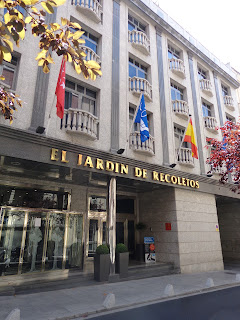
First Stop: the Museum of Deccorative Arts where for 3 Euros you are treated to 4 floors of embroidery, tapestries, woodworking, tiles, pottery and traditional pieces of finely crafted wares for the home and church. They had some really interesting timelines that showed the evolution of pottery and ceramics in Spain. My favorite room was a full size kitchen that had floor to ceiling tile walls decorated with imagery of the houshold characters perorming their daily duties, as well as just about everything one might expect to find in a 15th century kitchen.
I loved this jar from the 15th century. It looks like a goose, no?
Check out the Kitchen maid about to brain the cat for stealing a fish! Ha-ha! Run, kitty!
From here we walked down to the Reina-Sofia, another of Madrid's wonderful museums.
FYI: entrance to the three best museums in Madrid can be had for the bargain price of a Madrid Museo Pass = 21Euros. Buy one of these not only lets you skip the ticket line, but will ensure that you actually go inside all three museums. Sometimes those park benches can look pretty inviting.
The main attraction at the Reina Sofia is Picasso's masterpiece, Guernica.
It was very impressive in its full scale. I've only seen it in pictures, and I have to admit, it was disturbing. In case you're not familiar with this piece here's the short version: Franco, Hitler, and Mussolini decided to let their airforces practice their bombing strategies on a little Basque town called Guernica during the Spanish Civil War. I guess they figured no one would care about Guernica, except, of course, the citizens of Guernica. Picasso was comissioned to create a work in response.
Side note: While people watching in the city center we saw several anti-Franco protests. Now, you might be wondering why we need to protest someone who's been dead for nearly 40 years, but I guess it's never a bad idea to remind everybody what happens when facists get together.
Tile in Madrid: a few notes, a few pictures.
Almost every street sign is a tile installation of 6-12 square tiles, hand painted with the name of the street and some kind of relevant imagery. I love this! Not only do they give you the name of the street you're on, but they give you a little taste of the cultural relevance of the street, or at least, of the name.
Many of the local restaurants and small businesses advertize their wares and services with tiled store fronts. I absolutely love this! I think the bright, bold colors are eye catching and cheerful, the permanance of the information gives you the sense that they know what they're doing and they've been doing it a long time, and the sleek, clean finish of the store front just seems more inviting.
Now THAT'S a set menu!
Up and out to the Thyssen-Bornemisza, one of the trifecta of Madrid's Art museums. Here's some info on the Thyssen:Thyssen Museum.
Currently featuring a Hopper retrospective, the Thyssen reminded me alot of the MFAH at home. It seemed more accessible, more comfortable. Or maybe I just really like Hopper. I found it amusing that I went to Madrid to see an American artist, but I really enjoyed it. They included pieces by Manet and Degas that helped so much to draw parallels between the compositions and made it so clear where Hopper was coming from, stylistically. I never really saw his work as post impressionistic, but when you see it next to a Manet it couldn't be more clear. Two big thumbs up for the Hopper exhibit at the Thyssen.
Then, around the corner to the Prado. This is the biggest and most impressive of the three museums. It's alot like Paris' Louvre, in that it's impossible to see everything and one should really pick and choose to avoid being overwhelmed by masterpiee after masterpiece. Highlights at the Prodo include portrait by Albrecht Durer, Raphael, and Velazquez. Also, many great works by Titian, El Greco, Rubens and Rembrant. Although, I must admit, I was more excited to see my favorite Chagall. Their collection of classical sculpture was also really interesting, and beautifully displayed.
More info on the Prado here:Prado
We spent our evening on a Tapas Tour. I cannot recommend this excursion highly enough. It was awesome. Our guide, a "Limey" as my brother would say, (English bloke) took us to 4 of the best off-the-tourist-map Tapas bars. He spoke fluent Spanish and was well versed in Madrid's history and culture. He talked almost non-stop while plying us with delicious food and drink. An evening well-spent, and paid for dearly the next morning.
DAY 3:
Head in hands, we made our way to the train station. Today: Toledo. A beautiful medeival town only 30 minutes from Madrid by high speed train.
Things don't appear to have changed too much over the past 1,000 years in Toledo. There are a few more cars and Taiwanese tourists that there were back then, but it's really a lot like time traveling to hike up and down these narrow, winding alleys. You can never see more that 50 yards ahead of yourself so you have no idea what's around the next corner. Could be a dead end, could be a Cathedral.
In the Treasury of the cathedral, they had a collection of gorgeous illuminated manuscripts from the 1200's. It's such a thrill to see in person the relics of antiquity that I teach my students about in class.
These manuscripts were illuminated at the monestary in toledo. Another glorious building.
Some gorgeous tile advertising for the convent in Toledo. The nuns there are bakers and sweet-makers. They provide all the num-nums for the local shops and have a small store in the courtyard of the convent.
Just about every business, place of historical interest, and street corner had a tile sign telling you all about it. I love the artistry of the tile sign, as well as the implied confidence. When things have been as they are for several hundred years, you might as well make the sign permanent.
The last few hours of the Madrid leg of this journey were spend walking around and people watching. Always fun. There were two noteworthy art-related happenings that we "happened" upon.
If you are familiar with the "Cow Parade" that has made it's way around the U.S. over the past few years, there were two similar, simultneous parades going on in Madrid. A shoe parade, and a penguin parade.
I get the shoes, Madrid...fashion...style...chic. But, penguins?
BARCELONA
The Arc de Triumph
This fountain is in one of the city parks near the beach. It feeds into a pond where you can rent little rowboats.
Just a few people enjoying the beach on a beautiful Saturday.
Sarada Familia: Gaudi's still unfinished cathedral in the center of old Barcelona. Such a beautiful and bizarre mixture of gothic architecture and naturalism. The exterior sculptures read like a graphic novel of Jesus' life and death. I have never seen anything like it. I imagine the people of Barcelona had some strong opinions about it when it first went up.
Inside the building there are dozens of Gaudi's models and preliminary drawings in the Sagrada Familia museum.
The interior architecture exudes Gaudi's modernist naturalism. Everwhere you look you see butterfly wings, bones, shells, leaves.....
The ceiling looks like a spiny catepillar.
Gaudi's Park Guell :
Originally intended to be a planned community of 60 homes, it has 5 houses, one of which was Gaudi's own home. Ironically, Gaudi's house was designed by someone else, but the other structures were all from Gaudi's own imagination. His use of natural resources, consideration for existing natural structures, and incorporation of colorful mosaic and playful imagery make this place restful and energizing at the same time.
Skipping ahead.... MANISES
(I'll come back to Barcelona and Valencia later, but I just can't wait to tell you about Manises!)
Manises is a little village west of Valencia, about 20 minutes away by metro. It is home to many of the major tile and ceramics manufacturing facilities of the region. These factories have been located in Manises since the 1400's. Some of them are still operating on the original sites and using the same traditional method of clay preparation and tile making that were used then.
I have contacts at the Manises Tourist Office and at AVEC, the Asociación Valenciana de Cerámica. Both organizations have wonderful people working there who went above and beyond to make my visit interesting and worth while. The tourist office even provided an translator to show me around town, introduce me to local artists, and provide some history lessons. I am so impressed with the AVEC group, as well. This is an organization dedicated to the advancement and marketing of local pottery and ceramics artists. It provides a showroom for their work, facilities for international buyers to select merchandise for import, a school for training local people in the traditional arts as well as a school for children to experience ceramic arts programs on field trips. More infor on AVEC here:
AVEC
This is the old train station next to the metro in Manises. Know how you can tell it's a tain station? Because it has a tile mural of trains on it! (Love it!)
The first place we visited is the largest and oldest ceramics factory still in use in Valencia.
Our guide told us that the Moorish and Christian ceramic making traditions fused here about the 8th century and the Valencian tradition was born. We saw many examples of early tile and pottery in the local museums that showed a very clear evolution from early Moorish black and red ochre designs of animals on a white background, through, blue and white floral designs, gold luster baroque, polychrome rococo fanciness, into modern murals and commercial design.
This place had them all! Since it's been here the whole time and it's seen every stage of the game.
This cieling in one of their showrooms displays the earliest style of tile making.
I love the stylized animals and simple designs. They remind me of Greek design, the red on black look, but they have a more Eastern flavor.
These kitchen are so great! They're like snapshots of life from this period. And the artists always a naughty cat in there somewhere! I guess cats have always been trouble in the kitchen.
This is one of their many showrooms. Part museum, part showcase for buyers. These rooms are packed, floor to ceiling, (including the floor and the ceiling!) with gorgeous examples of their product.
After a thorough tour of their wares and a history lesson, we got to walk through the "factory" and meet a couple of the artists.
This generous gentleman offered to demonstrate both his tile making technique as well as his throwing techniques for me to film. I got some great footage of a genuine Valencian tile maker in action! I told him he will be famous, ha, ha...and he told me he's already famous. That shut me up.
These pieces are the traditional pottery from the 18th century that made this region famous. Everyone who goes through the AVEC school for training to work in one of these factories learns to make these very fancy, traditional pieces.
Here's a huge example. It was a gift from Valencia to the princess on the occasion of her marriage. (Which princess and marriage to whom, I did not get) I'm pretty sure that our guide was saying that it's a vessel designed to hold an herb to repell mosquitos. We saw alot of them in the many museums that we visited. But, you know what we haven't seen at all? Mosquitos.
The highlight of our day in Manises was a trip to see another "famous" local artist, Jose Royo, a.k.a. Pepe Royo. By contrast, his studio space was a small, cramped workshop on the other side of the main street in a row of leather making shops. His production is ona much smaller scale, and while he does produce the traditional wares of Manises in the famous style of the 18th century, his personal work and the work he teaches his students was much more interesting to me.
These are called "Officinas" or little offices. They're like ceramic diaramas of various professional offices or domestic scenes.
I bought one of his larger pieces that he just happened to have on hand in his studio. It's a ceramics studio, of course!
Best Souvenir EVER!
VALENCIA
Our day trip to Manises was only a short train ride from the center of Valencia city. (Valencia is the name of the city and the region.) I absolutely love this town. It's like a smaller, quieter Barcelona. And with beautiful beaches and a rich tradition of pottery and tile making, it is awesome! The main attraction in Valencia, for me, was the Museo National de Ceramica, also known as the Palace of the Marques de Dos Aguas. The magnificent collection is housed in the Marques palace, and a better venue is hard to imagine.
Here we have a mural from the palace and examples of the Marques' patio furniture, covered in glass mosaic.
A kitchen mural, of course. There was some debate about the species of the critter to the lady's right. Cat or monkey? I vote for cat, don't think monkeys were a big part of kitchen life.
This gorgeous vessel was reconstructed and pinned using ceramic staples. It is suspended so as to reduce pressure on the staples.
Another beautiful collection of classic blue and white Valencian tile.
I can't get enough of these tiled kitchens. Every tile behind the cooktop has an illustration of a plate of food or individual ingredient. It's like a cook by pictures guide for the kitchen staff.
These arm chairs and tables are fromm the Marques' entertaining rooms. They are porcelain! Even the table!
In the basement they display the Marques' carriage. Wow. Nice ride.
There was also a really interesting exhibit of the Llardro company, past and present. But photos were strictly prohibited. Their recent designs are really unusual.
For everyone else, the main attraction in Valencia is the futuristic City of Arts and Sciences.
These strange buildings house a dome theater called the Hemispheric, a museum of science, a museum of arts (theater), and the Oceanagraphic, which is alot like Seaworld, complete with Beluga whales and a dolphin show.
This installation was a delightful surpirse. It features "sweets" that represent each of the nations of the world, with an encyclopedic blurb on the front.
One of the most enjoyable things to do in Valencia, and in Spain in general, is to visit the local market place. Vendors have semi-permanent stalls from which the sell their goods. Each stall is decorated and had bright, beautiful signage to draw your eye.
The Mercado Central, in Valencia, is beautiful! An old train station that was saved from demlition and designated as a centralized marketplace for the growing city. It is bright and clean and really a fun spot in town.
The Valencians, like all Spanish, are very proud of their heritage. They hold annual Miss Valencia pagents during which contestants dress in their traditional finery. Some of the store fronts in town featured these amazing dresses.
My last day in Valencia I hit the beach. Such a busy two weeks deserved a relaxing finish. The beaches are bigger, cleaner, and less populated than in Barcelona. Another reason to love Valencia.
This was such an amazing trip! I learned so much, and had a great time doing it. CHEERS!












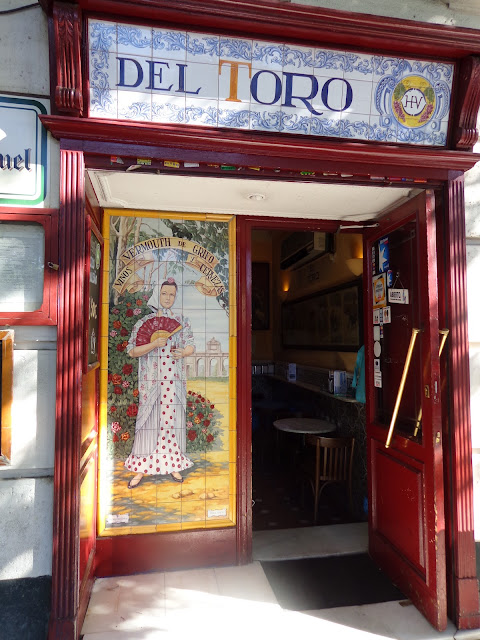
























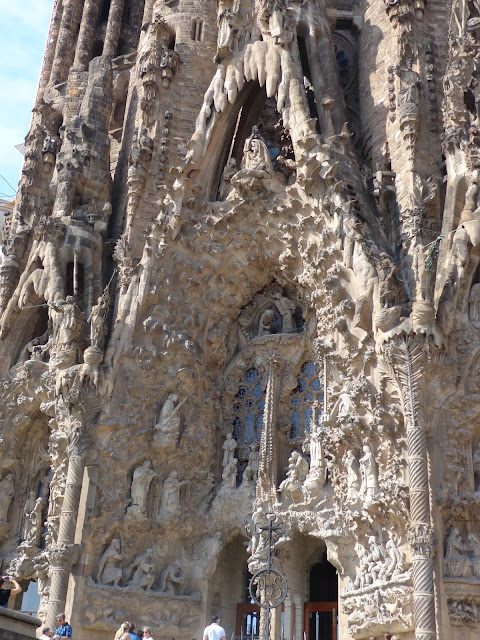







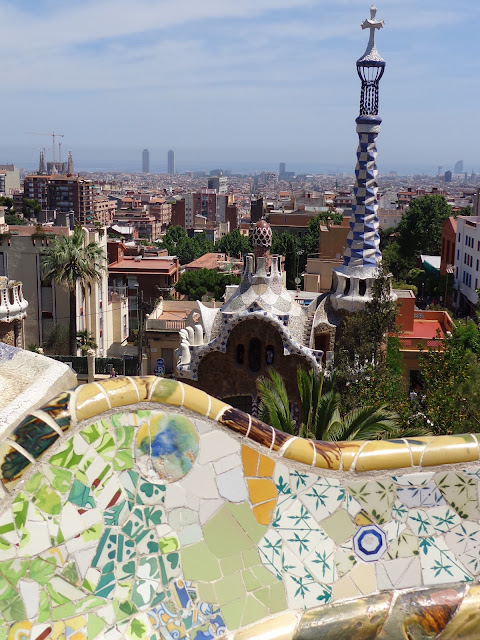












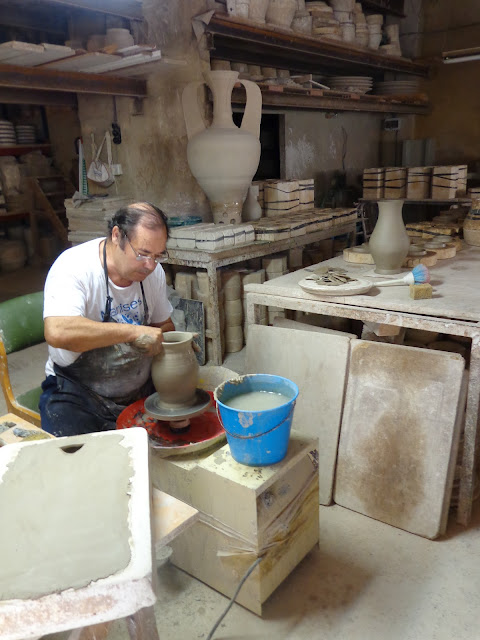

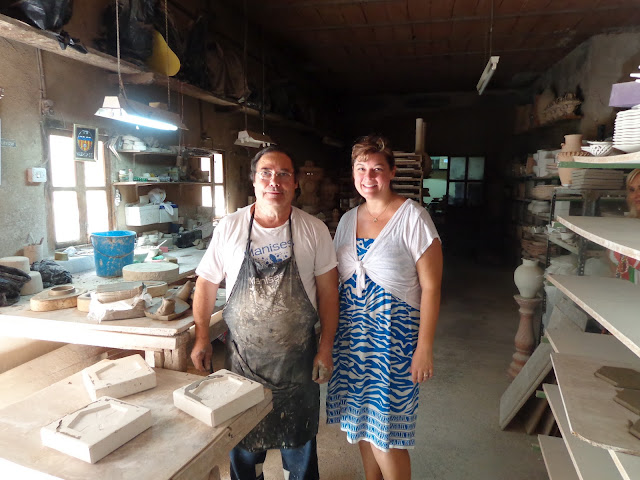






















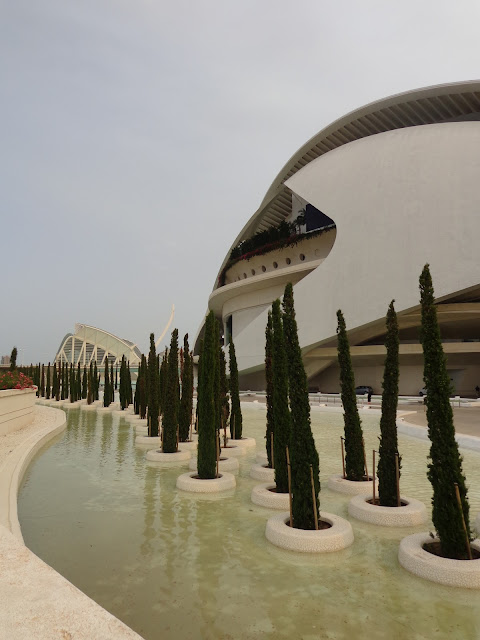







Welcome! I'm so glad you are joining me for what is sure to be an amazing adventure!
ReplyDeleteAs you may know, I was awarded a Fund For Teachers grant to travel and study in Spain this summer. I invite everyone to follow this blog for updates and pictures from my travels. I hope you will leave comments for me while I am traveling and we can enjoy an interactive study-abroad experience.
Oooooo...I'm gettin excited now! Just got back from Best Buy with my brnd new XPS! Yea, baby. All the geeks are jealous of my rad new ultrabook. Now to upload some photo and video editing software and play around. This thing is going to be awesome in Spain!
ReplyDeleteRight on! Can't wait to read about it and see the pictures!
ReplyDeleteLove that kitchen! Look forward to following your travels from Granbury, Texas.
ReplyDeleteEnjoying your posts! Didn't realize that Chegall was involved in so many mediums: painting, ceramics, stained glass design and set design. Also didn't know that he lived in Russia, Germany, France and the US. Maybe one of the reasons that you are drawn to his work is that you both lived in diverse cultures and are interested in so many art mediums?
ReplyDeleteKarin your mom is dictating to me a message. Ooo the sculptures, Ooo the cathedrals and Ooo the manuscripts an Ooo Toledo
ReplyDeleteGorgeous! Looks amazing so far!!
ReplyDeleteLove the tile. Thanks for sharing your trip!
ReplyDeleteLooking forward to seeing your next project.
ReplyDelete